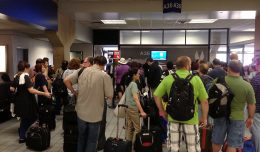It’s 5 p.m. The DC-8 crew of United Airlines Flight 173 is preparing for an approach after a routine day at work. Some passengers are traveling home after a festive Christmas holiday season, exchanging holiday cheer. Some are simply passing through. But as they near their destination – Portland, OR – the serene flight takes a different tone. The right main landing gear, having corroded beyond safe limits, created a malfunction during gear extension.
Electing to play it safe, the Captain decided to burn as much fuel as possible before landing with a possible collapsed gear. But despite his good intentions, he failed to keep in check the most insidious danger to any flying endeavor: the Human Factor.
Within the next hour, a landing gear malfunction turned into a fuel exhaustion, and the situation quickly degraded from abnormal to fatal.
At 6:06 p.m., the First Officer told the Captain, “We’re going to lose an engine…” The Captain replied, “Why?” The FO again stated, “We’re losing an engine.” Again, the captain asked, “Why?”
The FO responded, “Fuel”.
On December 28, 1978, at 6:15 p.m., United Flight 173 crashed into a wooded section of Portland suburbs after all four engines flamed out from fuel starvation. 2 crew members and 8 passengers died, with many others seriously injured.
The NTSB determined the following probable cause:
“The failure of the captain to monitor properly the aircraft’s fuel state and to properly respond to the low fuel state and the crewmember’s advisories regarding fuel state. This resulted in fuel exhaustion to all engines. His inattention resulted from preoccupation with a landing gear malfunction and preparations for a possible landing emergency.”
The NTSB also determined the following contributing factor:
“The failure of the other two flight crewmembers either to fully comprehend the criticality of the fuel state or to successfully communicate their concern to the captain.”
The 70’s were a dark decade for the world of aviation. Many high profile accidents and countless deaths occurred.Most, however, had a common denominator: Human Factors. The ensuing investigations of United 173, as well as the infamous Everglades crash of Eastern Airlines Flight 401 (1972) and the deadly Tenerife disaster (1977) ushered Human Factors into a new era, bringing the dawn of what we now commonly know as Crew Resource Management (CRM).
Through their work following the 70’s, investigators discovered that 70 to 80% of aviation accidents involved human error rather than equipment failure or weather hazard. NASA’s later studies found that the majority of crew errors consist of failures in:
– Leadership
– Team Coordination
– Decision Making
Under the umbrella of the International Civil Aviation Organization (ICAO), the aviation community decided to create an international standard to study and implement notions that would eventually become the core of aviation safety. They turned to psychologists to develop new kinds of psychological training for flight crews to face the new challenges they had just uncovered. That training focuses on:
– Group Dynamics
– Interpersonal Communications
– Decision Making
What is CRM and why do we need it?
CRM is the modern term for a very specific spectrum of Human Factors. To fully understand how CRM works and why it exists, let’s first take a step back and look at the “big picture”. The field of Human Factors focuses on “optimizing human performance and reducing human error.” It incorporates the methods and principles of behavioral and social sciences, engineering and physiology. ICAO now defines Human Factors through the “SHELL” model, named after the interaction of its different components:
– Software (Rules, SOP, etc)
– Hardware (Aircraft components, design, etc)
– Environment (Weather, social influences, etc)
– Liveware (Liveware)
The human element (Liveware) is at the center of the model that represents a modern air operator. It is the most critical component. Because of this, it is also the most error prone – interacting directly with the other parts constantly.
However, the SHELL model suggests that the human is rarely, if ever, the sole cause of an accident. So why do 3 out of 4 accidents still result from performance errors made by two capable, skilled, healthy crew members? The need for a focused study of Liveware->Liveware interaction, or Crew Resource Management, now becomes clear. It is defined by the ICAO as:
“The interaction between central human operator (Pilot Flying) and any other person in the aviation system during performance of tasks.”
These interactions can influence behavior and performance positively and negatively. They include:
– Leadership
– Crew cooperation, coordination and communication
– Teamwork & Interpersonal relations
– Personality and attitude interactions
By studying the L-L interface, we can develop CRM programs and standards (SOP, for example) to limit or eliminate the potential threats or errors posed by mismatches.
In 1989, another high profile United Airlines accident happened. However despite a higher casualty count than its 1978 predecessor, this accident became a herald for exemplary CRM. As the Captain of United Airlines 232 during the well-known Sioux City accident, Capt. Al Hayes was made the poster-child for today’s Crew Resource Management training. His actions on that fateful day left clear lessons for many generations of pilots to come. He later described CRM himself through a powerful paraphrase: “A procedure and/or training in systems where human error can have devastating effects. Used primarily for improving air safety, CRM focuses on interpersonal communication, leadership, and decision making in the cockpit.”
In today’s day and age, however, we quickly see CRM reaching a plateau in effectiveness. Why? Because it is taught as a reactionary tool, by recognizing that a discrepancy between what is happening and what should be happening (often the first indicator that an error or threat is occurring).
Threat and Error Management (T.E.M.)
CRM has been taught, studied and is now a common notion for most flight crews around the world. So how can we further enhance its ability to not only mitigate errors, but also prevent them? Modern CRM now takes a step back from the sole focus on Liveware->Liveware interaction, and brings back to view the “big picture” once more, giving the pilots the necessary tools to start acting and thinking preemptively rather than reactively.
In the early 90’s, Delta Airlines and the University of Texas partnered together to create what is now most airlines’ teaching standard: Threat and Error Management. Stemmed from LOSA – Line Operation Safety Audits, the joint research observed crews during training and regular line operation to identify:
– Potential threats to safety;
– How the threats are addressed;
– The errors such threats generate;
– How flight crews manage these errors;
– Specific behaviors that have been known to be associated with accidents and incidents.
In simpler terms, the resulting T.E.M. model is an overarching safety concept regarding aviation operations and human performance. It focuses on an important factor influencing human performance in dynamic work environments: the interaction between people and the operational context (the SHELL model). T.E.M. now enables us to plan and actuate preventive measures, actively reducing the number of instances where CRM would be needed to mitigate a threat to safety. But how does it work? Here is how the team from the University of Texas describes their model: “[…] risk comes from both expected and unexpected threats. Expected threats include such factors as terrain, predicted weather, and airport conditions while those unexpected include ATC commands, system malfunctions, and operational pressures. Risk can also be increased by errors made outside the cockpit, for example, by ATC, maintenance, and dispatch.
External threats are countered by the defenses provided by CRM behaviors. When successful, these lead to a safe flight. The response by the crew to recognized external threat or error might be an error, leading to a cycle of error detection and response. In addition, crews themselves may err in the absence of any external precipitating factor. Again CRM behaviors stand as the last line of defense. If the defenses are successful, error is managed and there is recovery to a safe flight. If the defenses are breached, they may result in additional error or an accident or incident”
The failure of a crew to properly manage an error could result in an undesired aircraft state, the aircraft “being unnecessarily placed in a condition that increases risk. This includes incorrect vertical or lateral navigation, unstable approaches, low fuel state, and hard or otherwise improper landings. A landing on the wrong runway, at the wrong airport, or in the wrong country would be classified as an undesired aircraft state.” There are three possible resolutions of the undesired aircraft state:
-Recovery is an outcome that indicates the risk has been eliminated;
-Additional error – the actions initiate a new cycle of error and management; and
-Crew-based incident or accident.
Countermeasures to undesired states are a normal part of daily operations and aircraft systems. CRM is human performance training in the use and development of skills, knowledge and attitudes to act as three essential countermeasures: Planning (Managing anticipated and unexpected threats), Execution (essential for error detection and response) and Review (Managing changing conditions of a flight).
Operational Applications
We have now come full circle, and the aviation industry is not only equipping pilots with the CRM tools, but with the full SHELL toolbox. However, many challenges remain today. Even with the most in-depth studies and training, some barriers still oppose operational safety, more often than not imposed by social influences. Take for example the recent crash of Asiana 214, where the debilitating cultural and hierarchal rules placed the whole flight in jeopardy, tying the hands and effectively gagging the FO who seemed to be the only crew member with a correct situational awareness. His speaking up could have easily prevented an unnecessary accident. So in times of doubt, fall back to your basic training and Aviate – Navigate – Communicate. Through the use of proper CRM (Leadership, Communication and Decision Making), these basic actions will always remain the core of a successful, safe flight.
Jean Denis Marcellin is a professional pilot by career, but a traveler by heart. Outside of work, Jean dedicates his free time to promoting Aviation and, more particularly, specializes in CRM through the proper understanding of the Human Factor and Leadership in the cockpit. He is also the founder and President of Plane&Simple Solutions. (www.PlaneSimpleSolutions.com)









